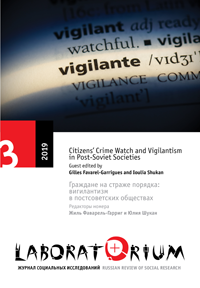Perspectives on Post-Soviet Vigilantism. Introduction
Main Article Content
Abstract
Moscow, 2012. About fifteen young men meet near a metro station in an outlying district to conduct an antidrug raid under the supervision of Arkadii Grichishkin, the leader of Molodezhnyi Antinarkoticheskii Spetsnaz (MAS, Youth Antidrug Commando). Some of them wearing hoodies, they complacently show the cameraman the weapons they carry: pickaxe handles, hammers, and an axe.1 Confident in themselves and in search of action, they move towards a kiosk selling cigarettes. One of them is filmed as he is buying some Spice—a popular synthetic drug, at that time not included on the official list of prohibited substances. When he gets back to the group and shows the Spice bag, the vigilantes cover the kiosk with stickers and graffiti (“Death sold here,” “I kill children with impunity”), damage it with their weapons, and throw a smoke bomb inside in order to catch the seller. In this video, the justice makers leave the alleged drug dealer to the police, but in other cases they often add their own punishments once the “prey” is captured, molesting him, tying him to a pole, or splashing him with paint. In one of their videos the alleged drug dealer is covered not only with paint but also with feathers.
Text in English
DOI: 10.25285/2078-1938-2019-11-3-4-15
Keywords
Vigilantism
Abstract 400 | PDF Downloads 334

